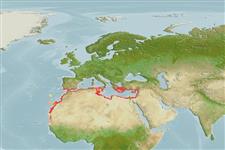Elasmobranchii (haaien en roggen) (sharks and rays) >
Myliobatiformes (Stingrays) >
Rhinopteridae (Cownose rays)
Etymology: Rhinoptera: Greek, rhinos = nose + Greek,pteron = fin, wing (Ref. 45335).
Issue
Considered valid in McEachran and Seret 1990 (Ref. 4441) but with a note that more recent authors consider it to be immature stages of R. marginata. Further study is needed to clarify problem (Ref. 4441). Tentatively valid in Last et al., 2016, for these differ subltly in their morphology (Ref. 114953:719).
Environment: milieu / climate zone / depth range / distribution range
Ecologie
marien benthopelagisch. Subtropical; 38°N - 15°N, 18°W - 36°E
Eastern Atlantic: southern Spain to Senegal, including the Mediterranean.
Grootte / Gewicht / Leeftijd
Maturity: Lm ? range ? - ? cm
Max length : 200 cm WD mannelijk / geslacht onbekend; (Ref. 6678)
Found in tropical to warm temperate coastal waters, but absent from islands of western Pacific. Often forming large groups swimming near the surface and quite destructive of commercial oyster and clam beds. Feeds on bottom-living mollusks, crustaceans and fishes. Seldom marketed. Ovoviviparous, gestation period up to one year with 2-6 embryos produced.
Levenscyclus en paargedrag
Maturities | Voortplanting | Spawnings | Egg(s) | Fecundities | Larven
Exhibit ovoviparity (aplacental viviparity), with embryos feeding initially on yolk, then receiving additional nourishment from the mother by indirect absorption of uterine fluid enriched with mucus, fat or protein through specialised structures (Ref. 50449).
McEachran, J.D. and B. Séret, 1990. Rhinopteridae. p. 71-72. In J.C. Quero, J.C. Hureau, C. Karrer, A. Post and L. Saldanha (eds.) Check-list of the fishes of the eastern tropical Atlantic (CLOFETA). JNICT, Lisbon; SEI, Paris; and UNESCO, Paris. Vol. 1. (Ref. 4441)
Status op de Rode Lijst van het IUCN (Ref. 130435)
Gevaar voor de mens
Harmless
Gebruik door de mens
Visserij: commercieel
Tools
Speciale rapporten
Download XML
Internetbronnen
Estimates based on models
Preferred temperature (Ref.
123201): 17.1 - 21.7, mean 19.7 °C (based on 136 cells).
Fylogenetische diversiteitsindex (Ref.
82804): PD
50 = 0.5039 [Uniqueness, from 0.5 = low to 2.0 = high].
Bayesian length-weight: a=0.01148 (0.00463 - 0.02844), b=2.98 (2.76 - 3.20), in cm total length, based on LWR estimates for this (Sub)family-body shape (Ref.
93245).
Trofisch niveau (Ref.
69278): 3.8 ±0.60 se; based on food items.
Weerstandsvermogen (Ref.
120179): Zeer laag, minimale populatieverdubbelingstijd meer dan 14 jaar (Fec=2).
Fishing Vulnerability (Ref.
59153): Very high vulnerability (85 of 100).
Nutrients (Ref.
124155): Calcium = 11 [2, 53] mg/100g; Iron = 0.54 [0.13, 1.54] mg/100g; Protein = 21.5 [16.4, 26.6] %; Omega3 = 0.193 [0.054, 0.609] g/100g; Selenium = 23.5 [7.3, 75.5] μg/100g; VitaminA = 8.83 [2.81, 27.94] μg/100g; Zinc = 0.539 [0.260, 0.995] mg/100g (wet weight);
